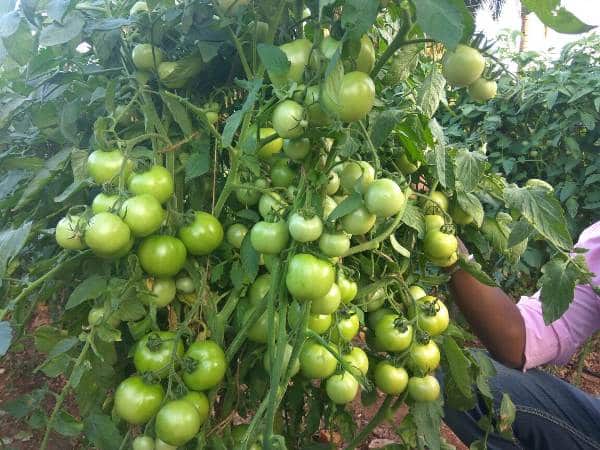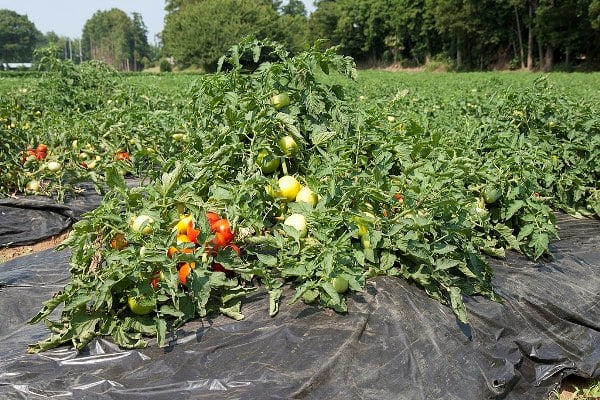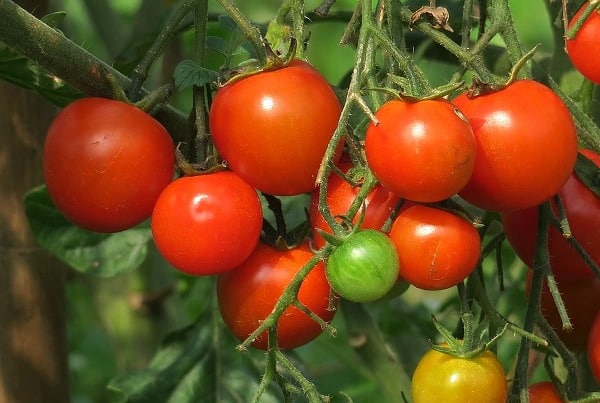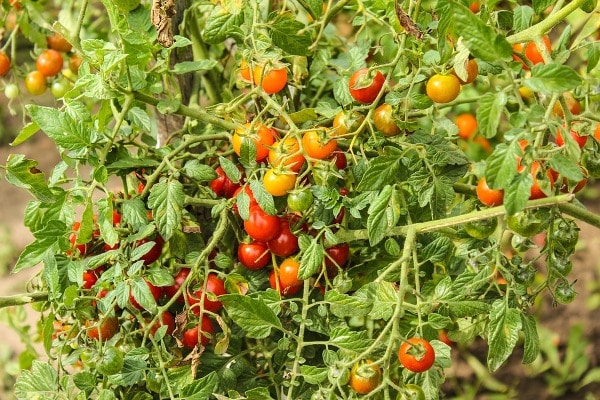Tomato farming project report
The following information is about the Cultivation Economics of Tomatoes and Tomato Farming Project Report.
Introduction to tomatoes
Tomato is a berry of the plant Solanum Lycopersicum belonging to the Solanaceae. The species of tomato have originated in the Western South American region and the cultivation was probably started by the people of Mexico. Generally, the tomato is a fruit, i.e. a berry consisting of an ovary along with the seeds of the flowering plant. However, the tomato has low sugar content than any other fruit and is hence considered a culinary vegetable. This is a widely used vegetable in almost every country in salads, juices, sauces, and in making other delicious cuisines.
The tomato farming project report describes the farming methods and the requirements for cultivating tomatoes in an open land; in the end, it also focuses on the investment required for farming and the profits associated with it.
Scope and Importance of tomato farming
China is considered to be the largest producer of tomatoes in the world followed by India in 2nd place. Overall tomato production in the world is around 1300 lakh tonnes. Brazil has the highest area under tomato cultivation (approx. 61,000 hectares). In India, Andhra Pradesh is the largest producer of tomatoes, producing around 15 lakh tonnes annually whereas Odisha is the largest producer area of tomatoes. (Approx area of cultivation is 100 thousand hectares). Cultivating short-duration crops like tomato facilitates farmers to grow three or four crops a year and offers scope for employment on a larger scale because vegetable crops are labor-intensive. The farmers can also adopt different cropping patterns with such short-duration crops.
The tomato is considered to be the most profitable crop of India and commercial cultivation can make a profitable agribusiness. This vegetable can be produced throughout the year and its demand in the local and international markets keeps the business active.
Tomato plant, and its properties

The tomato plant is considered to be a vine, which can grow to a height of 180 cm when supported by stalks. Indeterminate varieties of tomato plants are perennials, which die in temperate climates, whereas determinate varieties of tomato plants are an annual type of plants at all climatic conditions.
The leaves of the tomato plant are mostly compound in structure and are called as regular leaf plants. The length of the tomato leaf is approximately 10-25 cm. Each petiole has 5 to 9 leaflets on it and is odd-pinnate. The leaflet of the tomato plant is 8 cm. The stem and leaves are densely hairy in nature.
The flowers of the plant are yellow in color with five pointed lobes on the corolla. The width of the flower is 1 to 2 cm and they grow in clusters.
The tomato is a berry, which develops from the ovary after fertilization. The flesh of the tomato has pericarp walls. The vegetable has a hollow space that is filled with seeds, and moisture.
The plant is a dicot and grows as a series of stems having a terminal bud at the tip, which actually develops fruits or tomatoes.
Read this: Organic Potato Farming.
Cultivars or varieties
There are many cultivars of tomato found in India that are exclusively cultivated depending on the requirement and demand in the market. Some of the high yielding varieties and the disease resistant varieties are developed by the research institutes to increase the productivity of the farm. Common varieties of tomatoes found in India are:
Rajini
- Early growing variety is suitable for long-distance transportation.
- Produces round fruits.
Rashmi
- Determinate variety with firm and smooth fruits.
- An exclusive variety that is resistant to Verticillium and Fusarium wilts.
Vaishali
- Fruits are of medium size (about 100 g).
- Suited for cultivation in summer and hot humid climates.
- Mostly used in juice preparation.
Rupali
- Has good foliage cover with red, round and smooth fruits.
Pusa early dwarf
- The average yield of the crop per acre of land is 15 tonnes.
- Can be harvested in 75-80 days of transplantation
- Fruits have a flat base with yellow stems.
Pusa ruby
- Uniform ripening variety with a yellow stem end.
- Sowing is done during autumn-winter or spring-summer cycle.
Pusa 120
- Fruits are smooth in texture with medium to large size.
- It is resistant to nematodes.
Sioux
- The fruit has low keeping quality and is suitable for short distant markets.
- Fruit is round in shape with yellow stem end.
Marglobe
- This variety is suitable for hilly area cultivation.
- Late maturing variety.
- The stem end is green and the fruit is juicy.
Co1
- Suitable for growing in the South Indian region.
- Uniform ripening variety.
- Round fruits with yellow stem end.
Best of all
- Fruits appear in clusters.
- Suitable for hilly regions.
- The firm, round shaped fruits with a green stem.
Arka Abha
- The weight of the fruits is 75 g.
- Maturity is obtained in 140 days.
- Resistant to bacterial wilt.
- The average yield is 17 tonnes.
Arka Alok
- Mature in 130 days.
- You can expect an average yield of 18 tonnes/acre.
- Used for table purposes.
Arka Ashish
- It is a semi-determinate variety.
- Plants have dark green foliage.
- Tolerant to powdery mildew.
- Fruits mature in 130 days.
- Yield is 15 tonnes per acre.
- Used for processing purpose.
Arka Abhijit
- The weight of each fruit is 70 g.
- Keeping quality is 17 days.
- Resistant to bacterial wilt.
- Ready for harvest in 140 days.
- The average yield is 26 tonnes per acre.
Arka Ahuti
- Semi-determinate variety.
- Mature in 140 days.
Arka Saurabh
- Plants have light green foliage.
- The weight of the fruit is 70-75 g.
- Fruits mature in 140 days.
- Average yield per acre of land is 14 tonnes.
Arka shreshta
- The weight of each individual fruit is 70-75 g.
- Resistant to bacterial wilt.
- Fruits mature in 140 days.
- Fruits are round and have a light green shoulder.
- The fruit is either medium or large in size.
- The tomato plant has pale green foliage.
Arka vardan
- Mature in 160 days.
- Resistant to nematodes.
- All the other features are similar to arka vishal.
Arka vishal
- The fruit is large with a green shoulder.
- The weight of the fruit is 140 g.
- Can be cultivated as both Rabi and Kharif crops.
- The annual yield is 30 tonnes per hectare (average).
Soil and climate

The tomato is both a warm as well as a cool climate crop. Under the hot weather conditions, the plants need irrigation. The tomatoes can be grown at an altitude of 1500 m above the MSL and require an annual rainfall of 60-150 cm. The ideal temperature required for the cultivation of tomato is 20-25˚C, but for the exclusive red color of the vegetable, the plant needs a temperature of 21-24˚C. Excess heat can burn the plants, flowers, and fruits, whereas extreme lower temperatures can reduce the production and color of the fruit. One should understand that the plants cannot tolerate high humidity and frost conditions.
Tomato plants can be cultivated in a wide range of soils with good draining properties. The soil should be deep and should have a minimum pH range of 6-7. Generally, sandy loam or black soil is considered good for tomato cultivation. The minimum depth of the soil is expected to be 15-20 cm for a healthy yield. The soil should be limed together with the supply of proper nutrients so as to facilitate healthy growth of the plant.
Land preparation and planting for Tomato farming
The land should be ploughed thoroughly at least 5 times before cultivation. Then the land should be levelled and elevated beds are prepared for planting tomato seeds. Sterilizing the land after ploughing is recommended to protect it from soil pathogens. The planting or sowing should be done 2 or 3 days after sterilization.
The tomato plant is a day-neutral plant and can be grown during any season. In Southern India, it has three growing cycles, i.e. December-January, June-July, and September-October. In the northern part of India, transplantation is done during July, October-November, and February.
The beds for tomato planting are prepared with a length of 3 to 4 m, width of 120 cm and height of 15 cm. Lines are marked on the beds and then the seeds are sown into the beds. Cover the seeds with loose soil and water them lightly. The beds are mulched with straw or green leaves to facilitate germination of seeds. If seedlings are being used for transplantation, then they are planted after 30-45 days of land preparation.
The spacing between the plants during rainy season planting is 75 x 60 cm and 75 x 45 cm for summer season crops.
Propagation methods in Tomato cultivation
The tomato plants are propagated using seeds or seedlings. Seeds are initially raised on nursery beds for a period of 30-45 days. Exclusive hybrid varieties of seeds are sown in plastic cups. Other varieties are normally sown in the nursery beds. The seeds should be treated before sowing with Trichoderma and dried under the shade. The depth of sowing the seeds is about half a cm. The land should be heavily irrigated before sowing and mulched accordingly. It is important to remember that seeds should be treated with chemical fungicides before sowing. Generally, Trichoderma @ 1 g per 150 g of seeds is used for the treatment. This helps in protecting the seeds from fungal and other pathogen attacks.

Transplanting the seedlings is done in shallow furrows or flatbeds, depending on the availability of irrigation beds. The seedlings are planted along the ridges during the rainy season.
Manure and fertilizers used in growing Tomatoes
Well decomposed manure @ 20 to 25 tonnes per hectare is supplied to the soil base during the land preparation. The basal fertilizer dose of Nitrogen @ 60 kg, Phosphorous @ 80 kg and potash @ 60 kg per hectare are applied after transplanting.
The tomato plants are supplied with 30 kg of nitrogen fertilizer after 30-45 days of planting. If tomatoes are being cultivated organically then application of organic manure is very important during the growing period. Vermicompost @ 1 to 1.5 tonnes per acre along with 10 tonnes of Farm Yard manure is supplied to the tomato organic farm.
Irrigation requirements for growing Tomato plants
The drip irrigation method is used to supply water to the tomato plants because it maximizes the yield of the tomato plants. Water is supplied to the plants at an interval of 6-7 days during the summer and at an interval of 10-15 days during the winter season.
This method of irrigation saves 60-70% water and helps in the increase of production by 20-25%. Care should be taken to keep the plants irrigated in drought areas because if the plants are irrigated suddenly after a long spell of dryness, there is a problem of fruit cracking.
Pest and disease control measures
Tomato plants are prone to fungal, viral and bacterial diseases such as Fusarium wilt, mildew, leaf blight, mold rot, mosaic virus and damping off. Managing diseases or preventing their occurrence is highly important because once the plants get those diseases, it is difficult to control them. The best way to prevent diseases is to use disease resistant cultivars and sterilize the soil before farming. Following a proper crop rotation schedule is also recommended. Care should be taken while watering the plants such that the leaves and flowers don’t get wet. Watering should be done only to the roots so as to avoid contamination and spread of fungal diseases. Extremely severe diseases should be treated with recommended chemicals.
Pest management should be done by using proper bio-pesticides. Neem based pesticides like the neem cake, neem seed kernel extract; neem leaf extract, neem oil etc. are all forms of bio-pesticides. The tomato plants have a threat from pests like fruit borer, whiteflies, leaf miner and root-knot nematodes. The management techniques for pest control are almost similar to that disease control measures.
Cultural practices of Tomato
Weed management is very important during tomato farming because they consume nutrients from the soil and also harbor insects and diseases, which destroy the crops in the long run. Diverse crop rotation with cover crops is very beneficial for tomato crop farming. The weed seeds and other propagules should be removed from the land during preparation. The first four or five weeks of planting needs scheduled weed management because this is considered to be the major growth period of the tomato plants.
Mulching is done during the initial growing period to conserve the soil moisture and also to prevent the occurrence of weeds. A black plastic mulch material of 50 microns thickness is considered to be a good option for mulching because it controls about 95% of weeds.
Tomato plants need support during the initial growth period. Stalking is done to keep the plants erect. Small bamboo sticks are placed along the plant and tied with string or wire. Doing so helps the plants to stand still such that the fruits do not expose to soil and water.
Harvesting and yield of Tomatoes

Tomato fruits can be harvested in different stages depending on their levels of maturity. The first harvest is obtained after 75 to 90 days of planting. The different stages of harvest are: green stage (generally harvested for long distance transportation); pink stage (local market varieties are harvested at this stage); maturity stage (these are also for the immediate sale in the local markets) and the full maturity stage (it is generally used for making other products like sauce, soups etc.)
The average yield of tomatoes is 250 to 400 quintals per hectare. Excellent cultivation techniques and hybrid varieties can produce an average yield of 750 to 800 quintals per hectare of land.
Cost and profit analysis of Tomato farming/tomato farming project report/economics of tomato cultivation
The investment required for the cultivation of tomatoes on one hectare of land is described here. The investment considers some general things and doesn’t detail about transportation, electricity and land charges during cultivation. All the values presented here are just for reference and vary slightly from the original.
The charge of the labor: Rs 300 per day.
The charge of animal labor: Rs 100 per pair day.
| Material | Investment |
| Labor for tomato farming @ 150 days | 45,000.00 |
| Animal labor @ 10 days | 2,500.00 |
| Machine labor @ 2 hours | 1,200.00 |
| Cost of tomato seeds @ 0.58 kg per hectare | 5,000.00 |
| Manure @ 12 tonnes | 5,500.00 |
| Fertilizers (N, P and K) @ 150 kg | 5,500.00 |
| Irrigation charges + drip irrigation facilities | 75,000.00 |
| Plant protection chemicals | 2,000.00 |
| Other miscellaneous charges | 5,000.00 |
| Total investment | 1,44,700.00 |
Total yield from the farm: 170 quintals approximately.
Sale price of tomatoes per quintal: Rs 2000.
So the total income from the farm is: (total yield x sale price of produce per unit).
(170 x 2000) = Rs 3, 40,000.
Profit from the farm: (total income – total investment).
(Rs 3, 40, 000 – Rs 1, 44, 700) = Rs 1, 95,300.
Loans and subsidies for Tomato Farming In India
NABARD has an association with various banking agencies provides loans and subsidies to the farmers depending on the size of the project. Please visit the NABARD office or website, to understand the actual assistance procedure and type of subsidy available for tomato farming.
In case if you are interested in this: Onion Growing Tips, Tricks, and Secretes.
- Economical Aquaculture: A Guide to Low-Budget Fish Farming
- 15 Common Planting Errors That Can Doom Your Fruit Trees
- How to Make Houseplants Bushy: Effective Tips and Ideas
- Innovative Strategies for Boosting Coconut Pollination and Yield
- Pollination Strategies for Maximum Pumpkin Yield
- The Complete Guide to Chicken Fattening: Strategies for Maximum Growth
- Natural Solutions for Tulip Problems: 100% Effective Remedies for Leaf and Bulb-Related Issues
- Revolutionizing Citrus Preservation: Towards a Healthier, Greener Future
- Natural Solutions for Peony Leaf and Flower Problems: 100% Effective Remedies
- Maximizing Profits with Avocado Contract Farming in India: A Comprehensive Guide
- Natural Solutions for Hydrangea Problems: 100% Effective Remedies for Leaf and Flowers
- The Ultimate Guide to Choosing the Perfect Foliage Friend: Bringing Life Indoors
- From Sunlight to Sustainability: 15 Ways to Use Solar Technology in Agriculture
- The Ultimate Guide to Dong Tao Chicken: Exploring from History to Raising
- The Eco-Friendly Makeover: How to Convert Your Unused Swimming Pool into a Fish Pond
- Mastering the Art of Delaware Chicken Farming: Essentials for Healthy Backyard Flocks
- 20 Best Homemade Fertilizers for Money Plant: DIY Recipes and Application Methods
- How to Craft a Comprehensive Free-Range Chicken Farming Business Plan
- Brighten Your Flock: Raising Easter Egger Chickens for Beauty and Bounty
- How to Optimize Your Poultry Egg Farm Business Plan with These Strategies
- Subsidy for Spirulina Cultivation: How Indian Government Schemes Encouraging Spirulina Farmers
- Ultimate Guide to Raising Dominique Chickens: Breeding, Feeding, Egg-Production, and Care
- Mastering the Art of Raising Jersey Giant Chickens: Care, Feeding, and More
- Ultimate Guide to Raising Legbar Chickens: Breeding, Farming Practices, Diet, Egg-Production